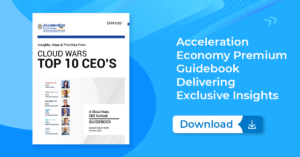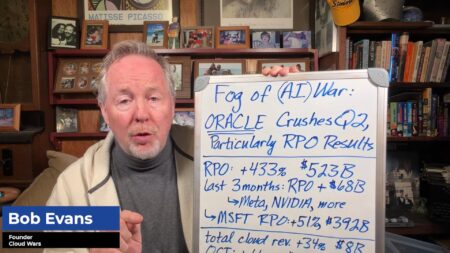
The stunning slowdown in growth at Salesforce will tumble to the unprecedented level of 10% in its new fiscal year, leading president and CFO Amy Weaver to refer to the 12 months that began Feb. 1 as “a transformational year.”
While I’m not exactly sure what that “transformational” term means, my guess is that it squarely represents a sharp shift in focus away from growth and toward profit.
Weaver at least hinted at that with this comment in the Q4 press release: “It’s a New Day at Salesforce and as we look ahead, I am excited for the opportunity in front of us as we continue to drive profitable growth.”
However, an objective view of the company’s Q4 results and its guidance for the coming year point to an entirely new reality for Salesforce, which for its first 23 years was all about growth, market share, and dazzling customers with cloud-native solutions its competitors could not match.
And for at least the last five years — and, I would guess, for many more years beyond that — the company’s growth rate never dipped below 20% until three months ago when it reported fiscal-Q3 revenue was up by only 14%. (For more on that, please see Salesforce Stumbles: Growth Rate at 5-Year Low in Q3.)
That 14% figure, plus the simultaneous departures of co-CEO Bret Taylor and Slack CEO Stuart Butterfield, and also Salesforce’s decision one quarter ago not to offer guidance, were clear indications that a “new day” has indeed dawned at the formerly high-growth company.
On the heels of those developments from three months ago, it was clear that yesterday’s results would reveal whether Q3 was a temporary stumble or a shift in direction. And as I look at the latest results and the guidance for the coming year, I think it’s clear that Marc Benioff’s company is shifting from a high-growth superstar to a steady-growth category leader whose new priorities are margins and profits.
The key numbers:
- Q4 revenue was $8.38 billion, up 14%. And decelerating growth aside, let’s acknowledge that’s a massive number that puts Salesforce second to only SAP on the list of the world’s largest enterprise-applications vendors
- For the fiscal year ended Jan. 31, revenue was $31.4 billion, up 18%
- Total remaining performance obligation (RPO) reached $48.6 billion, up 11%
- Guidance for Q1 ending April 30 is revenue of about $8.17 billion, up 10%
- Full-year guidance was about $34.6 billion, up 10%.
A little context on that RPO growth of 11%: My recent analysis of comparable numbers among some Salesforce competitors showed that RPO growth rate is much lower than Oracle (68%), SAP (35%), and ServiceNow (25%). Full details on that can be found in Oracle, SAP, ServiceNow Soar on Key RPO Metrics but Salesforce Drops.
We’ll have more analysis next week on the commentary offered by Benioff and his team on the Q4 earnings call, but I think it’s safe to say that Salesforce has hit middle age and is looking to settle into a quieter pace in the years to come.
To hear more data modernization, AI/hyperautomation, cybersecurity, and growth strategies from CIO practitioners, tune into Acceleration Economy’s Digital CIO Summit, which takes place April 4-6. Register for the free event here.










